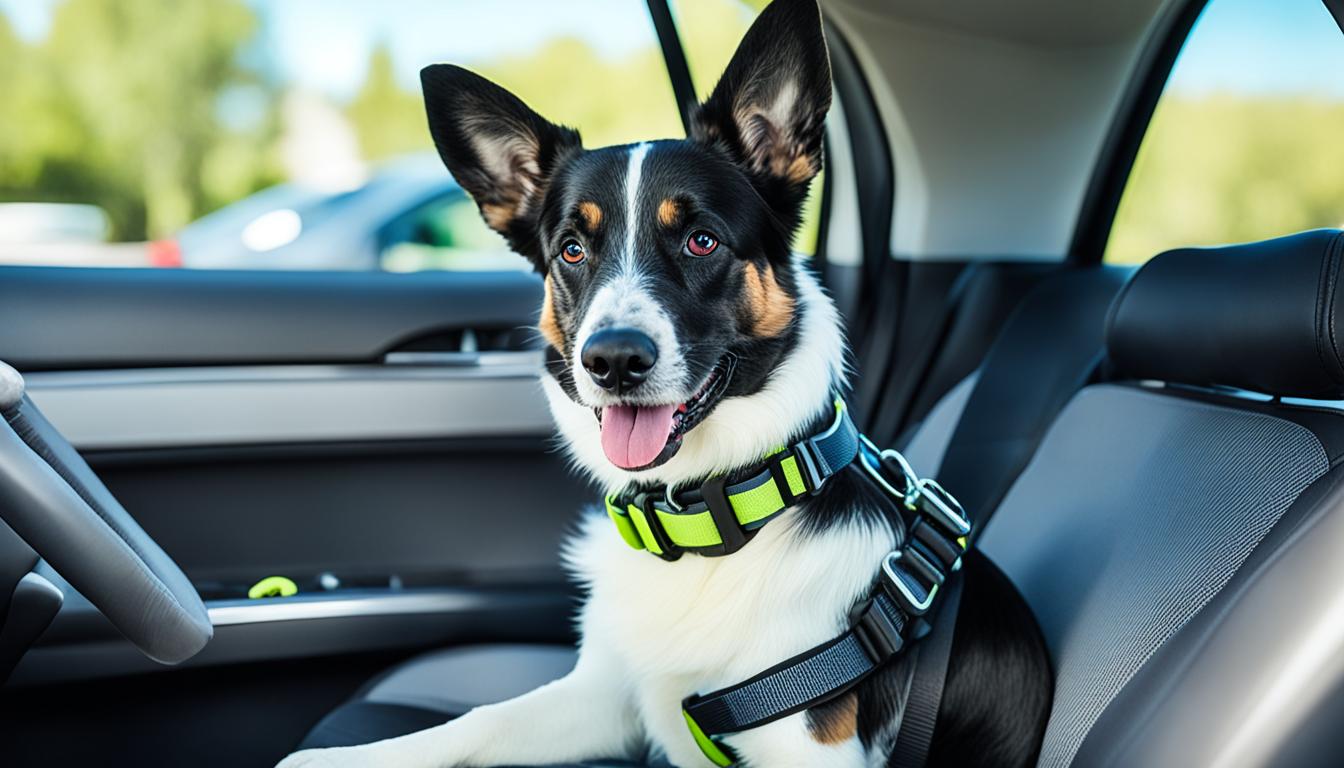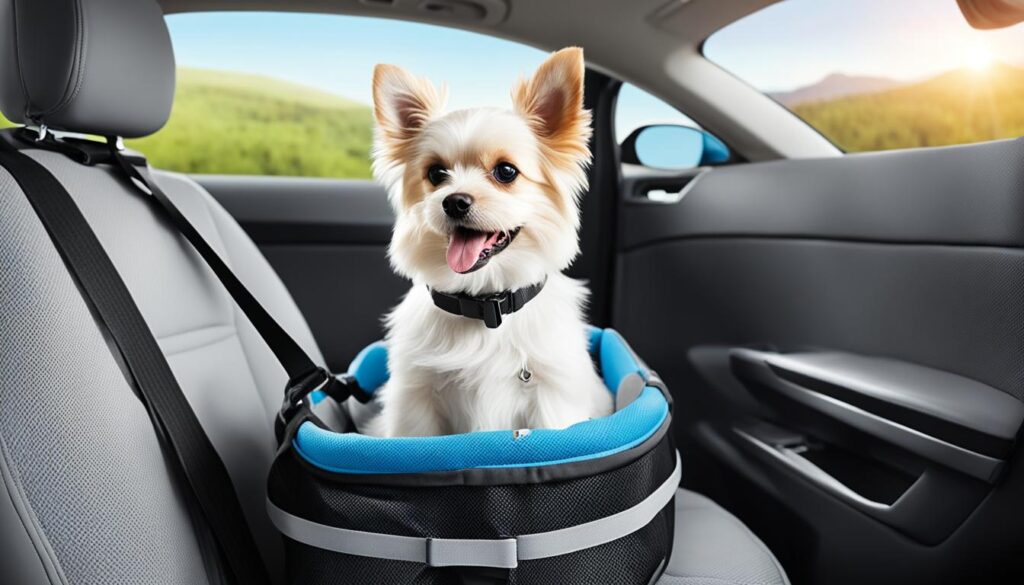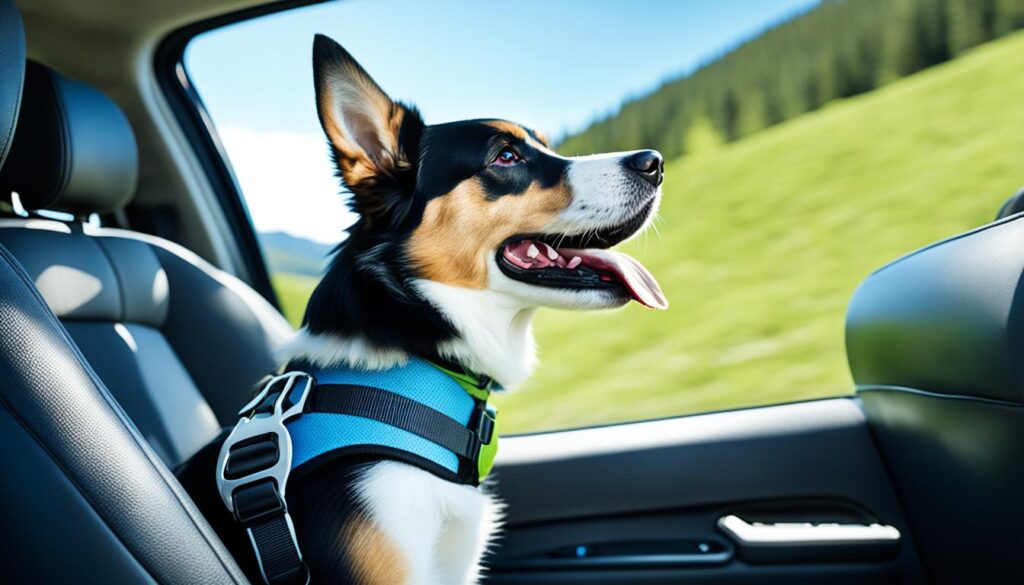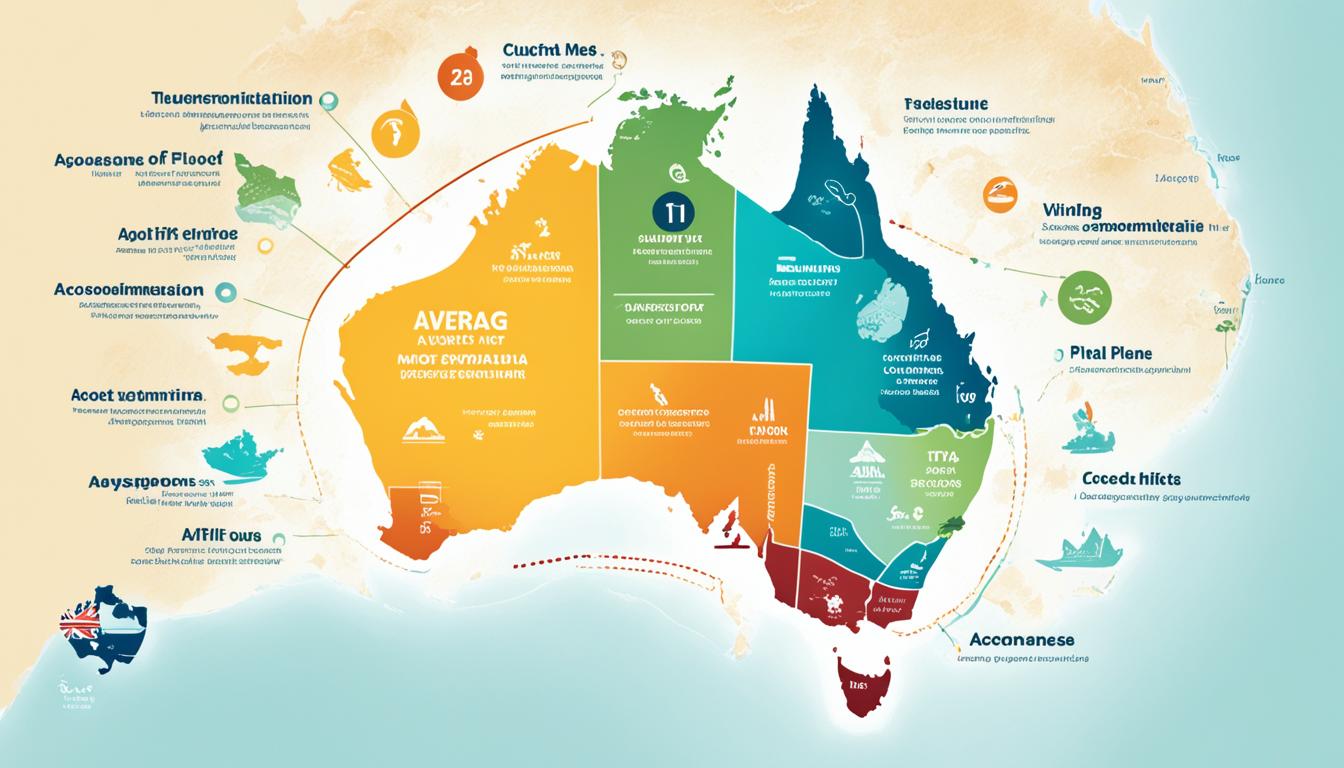
Planning a road trip with your furry friend? Traveling with pets can be a rewarding experience, but it requires careful consideration to ensure their safety and comfort throughout the journey. When it comes to traveling with a dog in a car, there are important factors to keep in mind to make the experience enjoyable for both you and your canine companion.
Key Takeaways:
- Prepare ahead of time, packing essential items for your dog and researching pet-friendly accommodations.
- Choose the appropriate car restraint, such as a dog seat belt, harness, or crate, to ensure your dog’s safety.
- Familiarize your dog with the car through gradual training and positive experiences.
- Secure your dog properly in the car to prevent any accidents or injuries.
- Make frequent pit stops to allow your dog to stretch their legs, relieve themselves, and stay hydrated.
Plan Ahead for a Smooth Ride
When embarking on a dog-friendly road trip, proper planning is essential to ensure a smooth and enjoyable journey. By taking the time to prepare in advance, you can make your four-legged companion’s travel experience comfortable and stress-free. Here are some dog car travel tips and essential considerations to keep in mind:
- Pack Your Dog’s Travel Essentials: Remember to bring all the necessary items for your dog’s well-being during the trip. This includes food, water, bowls, leash, waste bags, and any medication they may need. Additionally, it’s a good idea to pack their favorite toys or blankets to provide a sense of familiarity and comfort during the journey.
- Research Pet-Friendly Accommodations: Before hitting the road, make sure to find pet-friendly accommodations along your route. Look for hotels, campsites, or vacation rentals that welcome dogs, allowing you to rest and recharge without any hassle. Checking in advance ensures a stress-free stay for both you and your furry friend.
- Create an Itinerary: Mapping out your journey and identifying pit stops along the way is crucial. Dogs, like humans, need regular breaks to stretch their legs, relieve themselves, and stay hydrated. Planning your stops in advance prevents last-minute searches for suitable rest areas, making the trip more enjoyable for everyone.
- Consider Your Dog’s Comfort: Dogs can become anxious or uncomfortable during car travel, especially if they aren’t accustomed to it. To address this, provide your dog with a safe and cozy space in the car, such as a well-ventilated crate or an appropriate dog seat belt or harness. This ensures their safety and helps alleviate any travel-related stress.
By following these dog car travel tips and incorporating them into your planning process, you can set the foundation for a successful and enjoyable pet-friendly road trip. So, get ready to hit the road with your furry friend and create unforgettable memories together!
“A well-planned road trip with your dog can be an incredible bonding experience and an opportunity to explore new places together.”
| Benefits of Planning Ahead | Key Takeaways |
|---|---|
| 1. Ensures you have all necessary items for your dog’s comfort and well-being. | • Pack your dog’s travel essentials • Research pet-friendly accommodations |
| 2. Allows you to find pet-friendly accommodations along your route. | • Create an itinerary • Consider your dog’s comfort |
| 3. Provides opportunities for regular breaks and pit stops. | |
| 4. Reduces your dog’s anxiety and discomfort during car travel. |
Choose the Right Car Restraint
When it comes to traveling with your beloved canine companion, ensuring their safety is of utmost importance. Choosing the right car restraint is essential to provide a secure and comfortable environment for your dog during car journeys. Let’s explore some dog car seat guidelines and canine car safety tips to help you make the best choice.
Options for Car Restraints
There are several car restraint options available to keep your dog safe while traveling. These include:
- Dog seat belts: Designed to secure your dog in place and prevent excessive movement during the journey. They typically attach to your car’s seat belt buckle or latch system.
- Harnesses: Specifically designed to be used with car seats, harnesses provide a secure attachment point for seat belt restraints, allowing your dog limited mobility while ensuring their safety.
- Crates: Ideal for larger dogs or those who feel more comfortable in an enclosed space, crates provide a safe and secure area within your car for your dog to travel in.
Each option has its own benefits, and the choice depends on your dog’s size, temperament, and personal preferences. Here’s a table summarizing the key features of each car restraint option:
| Car Restraint | Key Features |
|---|---|
| Dog Seat Belts | Secure attachment to the car’s seat belt system Allows limited mobility Provides safety and reduces distractions |
| Harnesses | Specially designed for car travel Secure attachment point for seat belt restraints Prevents excessive movement |
| Crates | Enclosed space for security Suitable for larger dogs or those who prefer confined spaces Reduces anxiety and provides a safe environment |
Remember, not all car restraints are created equal, and it’s essential to choose a quality product that meets safety standards. Look for restraints that are crash-tested and approved by independent safety organizations. Additionally, consider your dog’s size, breed, and behavior when selecting the appropriate size and type of car restraint.
By choosing the right car restraint, you can ensure the safety and well-being of your furry friend during car journeys. Remember to follow dog car seat guidelines and implement canine car safety tips to provide a comfortable and secure travel experience for both you and your dog.
Familiarize Your Dog with the Car
Traveling with pets can be an exciting adventure, but it’s essential to ensure that your dog feels comfortable and safe during the journey. One of the key steps in preparing your furry friend for car travel is to familiarize them with the car environment gradually. By associating positive experiences with car travel, you can help your dog develop a sense of ease and confidence on the road.
Here are some tips to help you acclimate your dog to the car:
- Start with short trips: Begin by taking your dog on short car rides to nearby locations, such as the park or a friend’s house. This will help them get used to the sensation and sounds of being in a moving vehicle.
- Make it enjoyable: Create a positive association with car travel by bringing their favorite toys or treats along for the ride. Reward them with praise and treats after each successful car trip.
- Gradually increase the duration: Once your dog becomes more comfortable with shorter rides, gradually increase the duration of the trips. This will help them build tolerance for longer journeys.
Remember, patience is key when familiarizing your dog with the car. Each dog is unique, and it may take time for them to adjust to this new experience. By following these tips and providing a positive and relaxed environment, you can set your dog up for a stress-free and enjoyable car travel experience.
“Getting your dog comfortable with the car is an essential part of ensuring their safety and well-being during travel.”
Secure Your Dog in the Car
Ensuring the safety of your dog during car travel is paramount. Whether you’re embarking on a short trip to the park or a long road trip, it’s crucial to secure your furry friend properly. This not only protects them in the event of sudden stops or accidents but also prevents distractions that could endanger everyone in the vehicle.
There are several options available to keep your dog secure in the car. One popular choice is using a dog car seat or harness specifically designed for their safety. These restraint systems provide a designated space for your dog, preventing them from roaming around or being thrown off-balance during sudden movements. When selecting a dog car seat or harness, consider the size and weight of your dog, ensuring a proper fit that allows them to sit, lie down, and move comfortably.

“Investing in a high-quality dog car seat or harness is an investment in your dog’s safety and your peace of mind.” – Emily Johnson, experienced dog trainer
For larger dogs, using a secured crate or carrier in the car can also be an effective option. Ensure that the crate or carrier is well-ventilated and appropriately sized for your dog, allowing them to stand, turn around, and lie down comfortably. Secure the crate or carrier firmly so that it does not shift or move during the journey.
In addition to restraint systems, creating a comfortable and safe space for your dog is essential. Consider using a comfortable blanket or bed to provide them with a cozy area where they can relax and feel secure. Place the blanket or bed in a spot that minimizes their exposure to potentially dangerous objects or items that could cause injury during sudden stops.
Remember, never leave your dog unattended in the car, especially in hot weather. Even with the windows cracked, the temperature inside a car can rise rapidly, putting your dog at risk of heatstroke or other health issues.
Benefits of Securing Your Dog in the Car
Securing your dog in the car offers numerous benefits for both their safety and yours:
- Prevents them from becoming a distraction to the driver
- Reduces the risk of injury during sudden stops or accidents
- Gives them a designated space where they feel secure and comfortable
- Keeps them from jumping out of the car when the door is opened
By following proper dog car seat guidelines and ensuring their safety, you’ll be able to enjoy your journey together, knowing that you’ve taken the necessary precautions to protect your canine companion.
Make Frequent Pit Stops
During your pet-friendly road trips, it’s essential to make frequent pit stops to ensure the comfort and well-being of your furry companion. These breaks allow your dog to stretch their legs, relieve themselves, and stay hydrated. Just like humans, dogs need regular breaks from being confined in a car for long periods.
To make the most of these pit stops, always choose pet-friendly locations where your dog can roam around safely. Look for areas with designated dog parks or open spaces where they can exercise and explore. Additionally, remember to always clean up after your dog and dispose of waste responsibly.
Remember to pack your dog travel essentials, such as waste bags, water, and a collapsible water bowl. This way, you can easily provide them with hydration during the pit stops.
Benefits of Frequent Pit Stops:
1. Stretch their legs: Dogs, especially active breeds, need regular physical activity to keep them healthy and prevent stiffness or discomfort.
2. Relieve themselves: Giving your dog opportunities to relieve themselves during pit stops helps maintain their physical and mental well-being.
3. Stay hydrated: Proper hydration is crucial for your dog’s health, especially during long car journeys. Offering water during pit stops can prevent dehydration and help them feel refreshed.
By making frequent pit stops, you can ensure your dog remains comfortable and content throughout the road trip.
“Making pit stops during road trips is crucial for both you and your dog. It’s an opportunity for them to stretch their legs, relieve themselves, and stay hydrated. Plus, it serves as a refreshing break for you as well!”
As you plan your pet-friendly road trip, remember to research and mark suitable pit stop locations along your route. This way, you can anticipate and incorporate these breaks into your travel itinerary, making the journey enjoyable for both you and your furry friend.
Pet-Friendly Road Trip Pit Stop Checklist:
- Research pet-friendly locations along your route.
- Pack waste bags for easy cleanup.
- Bring a supply of fresh water and a collapsible water bowl.
- Consider having refreshing treats or toys available for your dog to enjoy during pit stops.
| Pit Stop Location | Description |
|---|---|
| Smith Park | A spacious dog park with separate sections for small and large dogs. Provides drinking water and waste disposal stations. |
| Green Acres Rest Area | A designated rest area with ample grassy spaces and pet waste stations. Offers a tranquil environment for your dog to stretch and relax. |
| Happy Trails Campground | A pet-friendly campground with hiking trails nearby, allowing your dog to enjoy nature and get some exercise. |
Remember, making frequent pit stops is not only beneficial for your dog’s physical well-being but also contributes to a smoother and more enjoyable journey for all. So plan ahead, pack your dog travel essentials, and incorporate these breaks into your itinerary to ensure a pet-friendly and stress-free road trip.
Keep Your Dog Comfortable
When embarking on a pet-friendly road trip with your furry companion, it’s essential to prioritize their comfort throughout the journey. By taking simple steps to ensure their well-being, you can make the car travel experience enjoyable and stress-free for both you and your dog.
Use Appropriate Bedding
Providing your dog with comfortable bedding is key to their comfort during car travel. A cozy blanket or a familiar bed can help them feel secure and relaxed throughout the journey. Opt for materials that are easy to clean in case of accidents or spills.
Maintain a Suitable Temperature
Just like humans, dogs are sensitive to temperature changes. Ensure the car’s climate control or ventilation system is set to a comfortable level for your furry friend. Avoid extreme heat or cold that could be distressing or dangerous for them.
Reduce Noise and Motion Sickness
Noise and motion can significantly impact your dog’s comfort during car travel. Minimize both by using noise-canceling earmuffs designed for pets or playing soft, calming music. Additionally, consider discussing motion sickness prevention options with your veterinarian to make the journey more comfortable for your dog.
Creating a serene and soothing environment for your dog during road trips is crucial for their well-being. By providing comfortable bedding, maintaining a suitable temperature, and taking measures to reduce noise and motion sickness, you can ensure their optimal comfort throughout the journey. Remember, a happy and comfortable dog makes for a more enjoyable pet-friendly road trip!
Don’t Leave Your Dog Unattended
When traveling with your furry friend, it’s crucial to never leave them unattended in a car, regardless of the weather conditions. This is especially important during hot weather, as it can quickly lead to heatstroke or other health issues for your beloved pet. Even leaving them alone for a few minutes can have serious consequences.
Heatstroke can be deadly for dogs and can occur within minutes in a hot car, even with the windows cracked open. Dogs are more vulnerable to heat than humans, as they regulate their body temperature differently. Leaving your dog unattended in a car can rapidly result in a dangerous increase in temperature, leading to severe dehydration, heat exhaustion, or even organ failure.
Remember, even if you’re just running a quick errand, it’s not worth risking your dog’s safety and well-being by leaving them alone in the car.
Always make sure to plan your trips accordingly to avoid situations where you would need to leave your dog in the car. If you must stop somewhere where your furry friend isn’t allowed, find a pet-friendly establishment where they can stay with you or ask a trusted person to watch over them outside the vehicle.
By prioritizing the safety and comfort of your dog, you can ensure a pleasant and stress-free travel experience for everyone involved.
Risks of Leaving Your Dog Unattended in a Car
| Risks | Consequences |
|---|---|
| Heatstroke | Dehydration, heat exhaustion, organ failure, or even death |
| Disorientation and Anxiety | Increased stress levels, fear, and potential escape attempts |
| Theft or Accidental Escape | Your dog may attract unwanted attention or accidentally wander off |
| Inadequate Ventilation | Poor air circulation can lead to respiratory problems or suffocation |
| Unpredictable Weather Changes | Extreme temperatures, storms, or other weather-related dangers |
Ensure your dog’s safety by simply avoiding the temptation to leave them unattended in a car. Remember, their well-being is in your hands, and by following this essential rule, you can prevent any potential harm or distress caused by leaving them alone in an uncontrolled environment.
Prepare for Emergencies
When traveling with pets, it’s important to be prepared for any unexpected situations that may arise. Having the right supplies and information can make all the difference in ensuring the safety and well-being of your canine companion. Here are some essential dog travel essentials and canine car safety tips to help you prepare for emergencies:
Create a First Aid Kit
Having a well-stocked first aid kit specifically for your dog is crucial. It should include items such as bandages, antiseptic solution, tweezers, and any necessary medication. Be sure to check the kit periodically and replace any expired items.
Gather Your Dog’s Medical Records
Before embarking on your trip, make sure to bring along copies of your dog’s medical records, including vaccination records and any important health information. In the event of an emergency, these records will be invaluable for veterinary care.
Research Emergency Veterinary Services
Prior to your trip, research and jot down the contact information of emergency veterinary services along your travel route. This way, if you need immediate assistance or have any concerns about your dog’s health, you’ll know exactly where to turn.
Carry Contact Details for Your Regular Veterinarian
In addition to emergency veterinary services, it’s essential to have the contact details of your regular veterinarian. They can provide guidance and advice, even from a distance, and may have valuable insights into your dog’s medical history.
Keep Identification Tags Up to Date
Ensure your dog wears a collar with up-to-date identification tags that include your current contact information. This will aid in reuniting you with your dog if they were to become separated during an emergency.
Microchip Your Dog
In addition to identification tags, consider microchipping your dog. Microchips provide a permanent form of identification and can greatly increase the chances of being reunited with your beloved pet in case they lose their collar or tags.
Emergency Contact Numbers
Include key emergency contact numbers in your travel itinerary, such as the nearest animal control agency, local animal shelters, and local police departments. Being prepared with these numbers can save crucial time in an emergency situation.
Dog Travel Emergency Checklist
| Essential Items |
|---|
| First aid kit |
| Copy of medical records |
| Contact details for emergency veterinary services |
| Contact details for regular veterinarian |
| Up-to-date identification tags |
| Microchip information |
| Emergency contact numbers |
By following these dog travel essentials and canine car safety tips, you can ensure that you are fully prepared to handle any unexpected emergencies while traveling with your beloved pet.
Have Proper Identification for Your Dog
When traveling with pets, it is crucial to ensure their safety and well-being. One essential aspect of pet travel is having proper identification for your dog. Accidents happen, and there is always a risk of your furry friend becoming separated from you during the journey. Having identification tags on your dog’s collar or microchipping them can significantly increase the chances of being reunited quickly in such unfortunate situations.
Identification tags are a convenient and visible form of identification for your dog. These tags typically include your contact information, such as your name and phone number, making it easy for someone who finds your lost pet to reach out to you. Ensure that the information on the tags is accurate and up to date. It’s also a good idea to include your destination contact information if you are traveling.
Microchipping is another effective way to ensure that your dog can be identified if they lose their collar or tags. A microchip is a tiny electronic device, about the size of a grain of rice, that is implanted under your dog’s skin. Each microchip contains a unique identification number that can be scanned by a veterinarian or animal shelter, providing them with your contact details. Remember to update your contact information with the microchip company if you change your address or phone number.
Remember that having proper identification for your dog is not only vital during travel but also in everyday situations. Accidents can happen anytime, anywhere, so it’s crucial to be prepared. Whether it’s during a road trip or a visit to a local park, make sure your dog is wearing a collar with identification tags or is microchipped to provide a secure and reliable way to be reunited if they become lost.
| Identification Option | Pros | Cons |
|---|---|---|
| Collar with Identification Tags | – Easily visible – Provides immediate contact information – Can include destination contact details |
– Can get lost or damaged – Information may become outdated |
| Microchip | – Permanent identification – Cannot be lost or easily removed – Provides reliable contact information |
– Requires a microchip scanner to read – Information must be kept up to date |
Create a Calm Environment
When traveling with your dog in a car, it’s essential to create a calm and soothing environment. This helps reduce stress and anxiety, ensuring a safe and comfortable journey for both you and your furry friend.
Here are some tips to create a peaceful atmosphere during car travel:
- Play Soothing Music: Gentle, classical music or specially composed calming tunes can have a relaxing effect on dogs. Consider creating a playlist of soothing melodies to play during the journey.
- Use Calming Pheromone Sprays: Calming pheromone sprays mimic the natural pheromones that mother dogs release, providing a sense of security for your pet. Apply these sprays to your dog’s bedding or crate before the journey.
- Provide Familiar Comfort Items: Bring along your dog’s favorite toy or blanket that carries a familiar scent. These items can provide comfort and reassurance, making your dog feel more at ease during the car ride.
- Create a Cozy Space: Ensure that your dog has a comfortable and secure space in the car. Use a cozy dog bed or a soft crate liner to make their designated area feel cozy and safe.
By implementing these strategies, you can help your dog feel relaxed and calm during car travel, minimizing any potential stress or anxiety they may experience.
“A calm dog is more likely to enjoy the journey and behave well in the car.” – Dr. Emily Thompson, Canine Behavior Specialist
Introduce Gradual Training
Training your dog to be comfortable and obedient while in a car is essential for their safety and the smoothness of your journey. By gradually introducing them to the car environment and minimizing distractions, you can ensure a stress-free and enjoyable travel experience for both you and your canine companion.
Step 1: Create Positive Associations
Start by associating positive experiences with the car. Begin with short trips to locations your dog enjoys, such as a park or a friend’s house. Reward them with treats and praise to reinforce the idea that the car is a fun and rewarding place.
Step 2: Gradually Increase Exposure
Once your dog becomes more comfortable with short trips, gradually increase the duration and distance of the journeys. This will help them get accustomed to longer car rides and build their tolerance to being in a moving vehicle.
Step 3: Introduce Car Restraints
As part of their training, introduce your dog to the car restraints you’ve chosen. Whether it’s a dog seat belt, harness, or crate, allow them to get familiar with it during short trips. This will help them associate the restraint with safety and security.
Step 4: Practice Obedience Commands
To ensure your dog’s safety and minimize distractions while driving, it’s crucial to teach them obedience commands specific to car travel. Practice commands such as “sit,” “stay,” and “down” within the confines of the car to reinforce their behavior in this unique environment.
Step 5: Gradually Increase Distractions
Once your dog is comfortable being in the car and following obedience commands, gradually introduce distractions that they may encounter during travel. This could include simulating the sound of moving traffic, opening and closing car doors, or even having another person sit in the backseat.
Remember, each dog is different, and training progress may vary. Be patient, consistent, and use positive reinforcement techniques throughout the training process. With time and practice, your furry friend will become a confident and well-behaved travel companion.
Having a well-trained and relaxed dog in the car not only ensures their safety but also enhances your overall travel experience. Follow these gradual training tips to help your dog become a pro at car travel while keeping them secure and minimizing distractions.
Consider Motion Sickness Prevention
When planning your journey with your furry companion, it’s crucial to consider motion sickness prevention to ensure a comfortable and stress-free car ride. Just like humans, some dogs may experience motion sickness during travel, which can cause nausea, drooling, restlessness, and vomiting.
Here are some effective tips to help prevent motion sickness in dogs:
- Gradually increase their tolerance to motion: Before embarking on a long car journey, it’s beneficial to accustom your dog to shorter trips. Start by taking them on brief drives to get them accustomed to the sensation of being in a moving vehicle. Gradually increase the duration and distance of these trips to help build their tolerance.
- Use medication if recommended by a veterinarian: In severe cases of motion sickness, your veterinarian may prescribe medication to alleviate your dog’s symptoms. These medications can help reduce nausea and calm their stomachs during the journey. It’s important to consult with your vet to determine the appropriate medication and dosage for your dog.
Motion sickness prevention is essential for a smooth and enjoyable car trip with your four-legged friend. By implementing these tips, you can minimize their discomfort and make the journey a positive experience for both of you.

Avoid Feeding Your Dog Before the Journey
When embarking on a pet-friendly road trip, it’s important to consider your dog’s dietary needs to ensure a smooth and comfortable journey. One key tip is to avoid feeding your dog a large meal right before the journey.
Feeding your dog a heavy meal before hitting the road can lead to potential car sickness and discomfort during the trip. Just like humans, dogs can experience motion sickness, and a full stomach can exacerbate the symptoms, making the trip unpleasant for both you and your furry companion.
Instead, it’s advisable to feed your dog a light meal or snack a few hours before the journey. This allows their stomach to settle and reduces the chances of them getting nauseous or vomiting during the car ride. It’s also a good idea to pack some dog travel essentials, such as treats or a small portion of their regular food, to offer them during designated pit stops along the way.
By following this dog travel tip and avoiding feeding your dog right before the journey, you’ll help keep them comfortable and minimize the risk of car sickness, ensuring you and your canine friend can fully enjoy your pet-friendly road trip.
“Feeding your dog a large meal right before traveling can lead to potential car sickness and discomfort.”
Conclusion
Congratulations! You are now equipped with valuable knowledge on how to travel with your dog in a car. By following these tips, you can ensure a safe and enjoyable journey for both you and your furry companion.
Remember to plan ahead by packing essential items for your dog and researching pet-friendly accommodations. Choose the right car restraint to keep your dog secure, and familiarize them with the car environment to minimize anxiety.
Make frequent pit stops to allow your dog to stretch their legs and stay comfortable. Keep them hydrated and ensure their comfort by using appropriate bedding and maintaining a suitable temperature. Never leave your dog unattended in a car, especially during hot weather.
Prepare for emergencies by having a first aid kit, medical records, and emergency contact numbers. Ensure your dog has proper identification, and create a calm environment using soothing music or pheromone sprays. Gradual training and motion sickness prevention will make car travel easier for your dog.
Remember, it’s important not to feed your dog right before the journey to prevent car sickness. By following these tips, you can make every car trip with your dog a memorable and enjoyable one. Safe travels!





